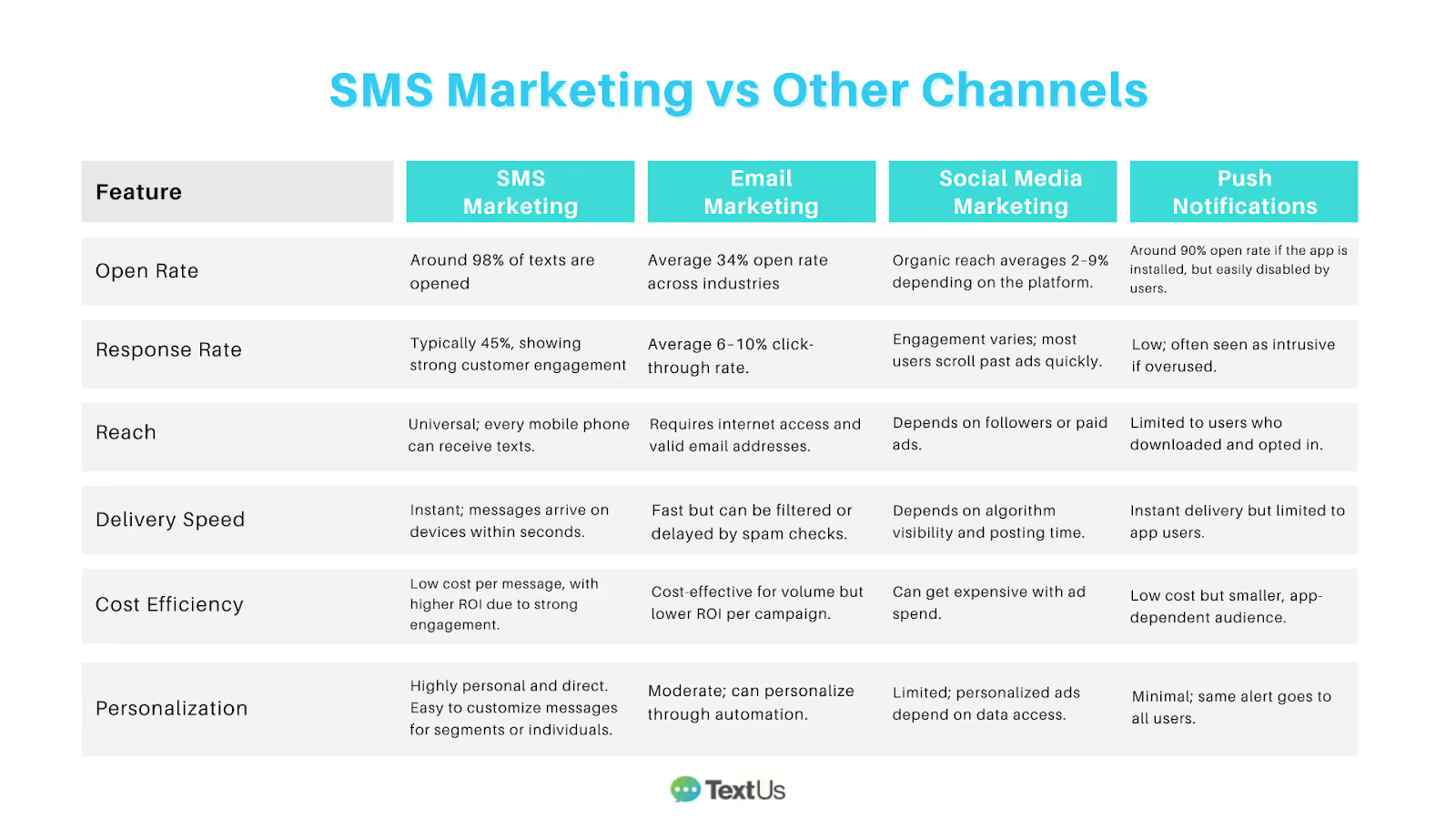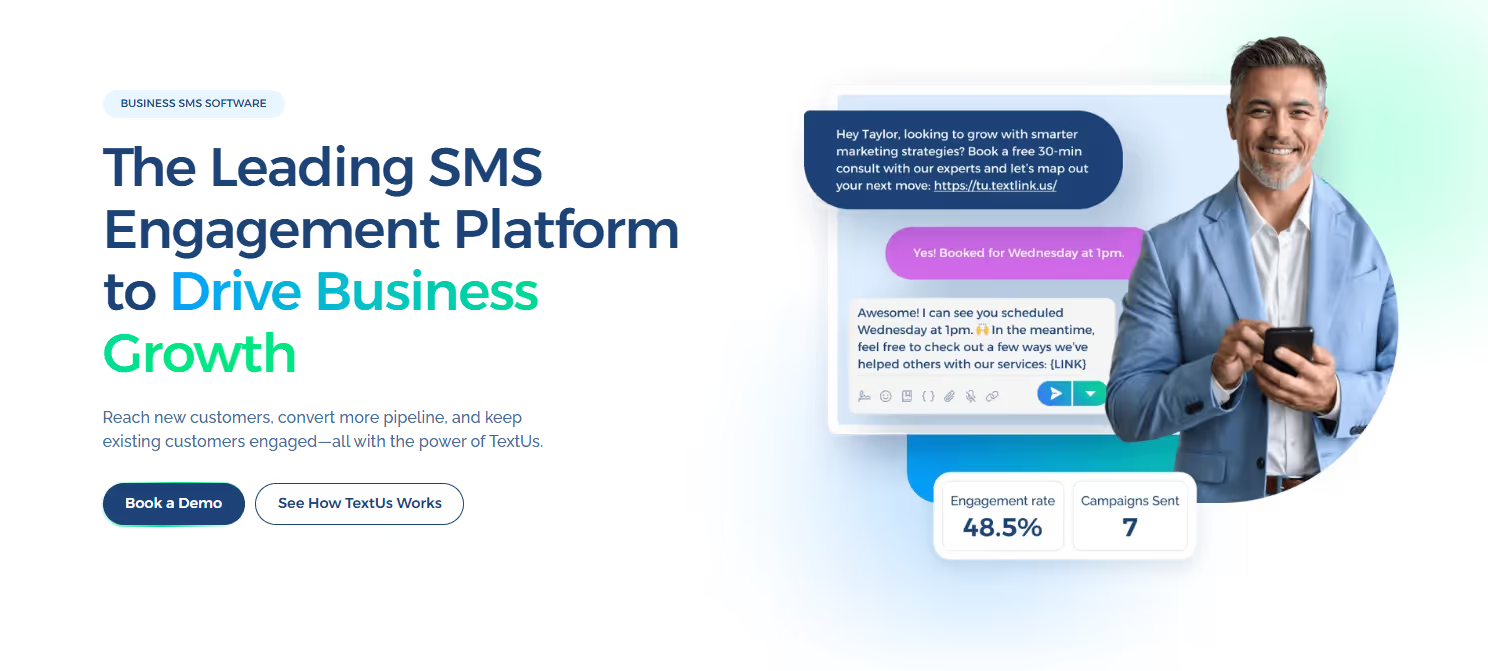How to Turn Holiday Hype Into Revenue With Seasonal Marketing
Learn how seasonal marketing helps you turn holiday hype into revenue and see how TextUs can help you stay top of mind all year long!
Published
November 5, 2025

Every year, customer habits shift with changing seasons. Holidays, weather, and cultural events all shape how people shop, think, and spend.
Understanding those shifts is what makes seasonal marketing important if you want to use them to your advantage. It creates seasonal excitement, improves engagement, and increases sales at just the right time.
But competition can be intense when every brand is fighting for attention. Many brands struggle with knowing when to push a message and when to hold back.
In this article, we’ll look at the factors that may affect your seasonal marketing campaigns and how to build a strategy that stands out. If you’re preparing for the next big holiday or looking to stay consistent all year, this guide will show you how to make every season a sales opportunity.
How Scarcity and Urgency Drive Buying Behavior
Seasonal events consistently push spending to new highs, and understanding why can help you create a successful marketing campaign.
According to market research from the U.S. Census Bureau, retail sales during the 2024 holiday season rose by 4% compared to 2023, reaching a record $994.1 billion.
For the full year, retail sales climbed to $5.28 trillion, up 3.6% from the previous year, showing that the biggest boosts still come during seasonal periods.
Scarcity and urgency are two of the strongest motivators in seasonal marketing. When people believe something is limited, they act faster.
Marketers often refer to this as “FOMO” (Fear of Missing Out). When a customer sees that a holiday deal ends in 48 hours or a product is “almost sold out,” it triggers immediate action.
Beyond immediate revenue, these seasonal surges help you attract customers. New shoppers looking for deals often turn into loyal repeat buyers when they have a good first experience.
You can also use this momentum by collecting emails, offering future discounts, and staying visible after the rush ends. That way, the benefits of a holiday campaign can last well beyond the season itself.
Incorporating creative seasonal themes and even leveraging user-generated content from satisfied customers can help you build meaningful connections with your audience.
Seasonal marketing isn’t just about a one-time sales boost. It brings predictable trends to create repeatable success all year round.
Types of Seasonal Marketing Campaigns
Different events call for various styles of campaigns, and understanding these categories helps you plan marketing efforts that connect with your audience.
Holiday-Based Campaigns
These are the most common and easiest to recognize. Think Christmas, Valentine’s Day, Halloween, Easter, and New Year’s.
People are already in a buying mindset during these holidays, which gives you a clear path for themed seasonal promotions.
For example, Amazon’s holiday delivery countdown builds anticipation each December, while cosmetic brands often release limited-edition gift ideas that align with their brand identity.
The key here is timing. Many consumers start preparing weeks or even months in advance. You can tease products early, offer pre-sale discounts, or create countdowns.
Even small touches, like changing website banners or packaging to match the holiday, help products feel more festive and desirable.
Weather or Season-Based Campaigns
Weather-based marketing revolves around environmental changes, such as hot summers, cold winters, or rainy months. It’s ideal for a seasonal business selling items like fashion, outdoor gear, or skincare.
For example, a sunscreen company might launch “Summer Protection Bundles” in May, while a café promotes “Winter Warmers” in December to maximize sales when demand spikes.
These campaigns connect with immediate customer needs and help you stay aligned with seasonal trends. People respond naturally to comfort in the cold and refreshment in the heat.
Event-Driven Campaigns
Event-based marketing focuses on specific cultural or commercial events that shape spending behavior, such as Back-to-School season, Black Friday, Cyber Monday, tax season, and wedding season.
Some companies create their own events, like Amazon’s Prime Day or Sephora’s annual Beauty Insider sale, to establish new traditions that new or existing customers look forward to.
These events are short but highly impactful. They rely on urgency, strong offers, and well-timed campaign support to deliver successful seasonal campaigns.
You can use personalized email campaigns, retargeting ads, and time-based offers that highlight the limited nature of the event.
Cultural and Local Celebrations
Not every campaign has to target global holidays. Local events such as festivals, regional holidays, or community gatherings can generate just as much buzz.
For instance, you might create a special drink for a local fair, or design products inspired by regional celebrations for your retail shop. These campaigns show cultural awareness and reflect genuine brand values, which help you connect more deeply with the community.
Customers love it when a brand celebrates something that’s meaningful to them personally. It turns marketing into a shared experience rather than just promotion.
How to Plan a Seasonal Marketing Strategy
A solid seasonal marketing strategy doesn’t start when the season begins, but rather months earlier. The best SMS marketing campaigns are built on timing, preparation, and data.
Here’s a quick step-by-step guide on how to create a plan that keeps your marketing ahead of the calendar.
Step 1. Identify Key Seasons Relevant to Your Business
Not every season will align with your products, but each industry has unique seasonal opportunities. The first step is identifying which periods align with your products, audience, and market.
A fitness center might see momentum in January as people focus on health, while a florist thrives in February and May.
Retailers, restaurants, and service providers can plan around special events such as back-to-school shopping, spring refreshes, or the winter holidays.
You can identify these patterns through website traffic patterns, historical sales data, and industry reports. Even small changes in timing can reveal valuable insights.
Once you know your high-performing seasons, you may allocate your marketing budget and inventory well before those peaks arrive.
Step 2. Research Audience Behavior and Timing
Timing is just as important as knowing the event itself. Some customers shop months in advance, while others wait for last-minute deals.
For example, searches for holiday decorations start appearing as early as October, which means a December campaign may already be too late to capture early buyers.
Using data and analytics tools helps you understand when people start searching, browsing, or engaging with marketing products tied to the season.
Then, you can connect that data with SMS marketing platforms to set up automated messages for each phase. For example:
- Early shoppers: Send exclusive previews or early access messages
- Mid-season buyers: Share limited-time discount codes via text
- Last-minute shoppers: Trigger reminders like “Final Day to Order for Guaranteed Delivery!”
SMS marketing works because it’s direct and personal. Unlike email, which may sit unread, text messages are opened almost instantly. That immediacy can push hesitant buyers to act.
You can also create SMS segmentation for customers based on their timing, such as early planners versus impulse buyers, and adjust your content accordingly.
Ready to make your next seasonal campaign your best one yet? Book a demo with TextUs today!
Step 3. Set Clear Goals for Each Campaign
Each seasonal campaign should serve a specific purpose. Ask yourself what you want to achieve: do you want to boost sales, strengthen relationships with your target audience, or build brand awareness ahead of a big event?
For example, a summer campaign might aim to highlight outdoor activities, while a winter one could focus on emotional storytelling that builds an emotional connection with customers.
If your goal is to boost customer engagement, SMS can outperform most other channels. You can track response rates, click-throughs, and coupon redemptions in real time.
A short, personal message such as “Take 20% off all weekend orders — today only!” can encourage customers to act quickly and convert instantly.
You can also review those results to gather insights that help you adjust future campaigns and better understand what resonates with your audience.
Step 4. Develop a Content and Promotion Calendar
A marketing calendar keeps everything running and prevents last-minute panic. It should outline when to create, schedule, and launch relevant content across all platforms.
A yearly calendar lets you plan visuals, messages, and promotions across all channels while keeping your brand voice consistent. You can break down the year into quarters that match your key events and specific seasons.
- January–March: Send motivational texts for new year goals
- April–June: Announce spring or travel sales
- July–September: Use bulk text messaging for flash sales and back-to-school promotions
- October–December: Combine festive visuals with holiday SMS countdowns
This organized approach keeps campaigns aligned and gives your creative team enough time to build content that stands out across digital channels.
Step 5. Choose the Right Marketing Platform
The success of your campaign depends on using the right combination of platforms.
Social media and marketing emails are ideal for storytelling and nurturing relationships. But SMS marketing practices are unbeatable for immediacy and engagement.
Text messages have some of the highest open and engagement rates of any channel, reaching above 98%. During busy seasonal campaigns, you can use SMS to send flash sale alerts, limited-time discount codes, or delivery reminders.

Another advantage of SMS is that it can support other channels. A coordinated campaign might use a social post to attract attention, an email to share full details, and a follow-up text to remind customers before the deal ends.
TextUs helps you build strong customer relationships through conversational texting. Instead of sending generic blasts, you can start one-on-one conversations that reflect your creative approach and tone.
Text Your Way to Higher Seasonal Sales—Try TextUs!
Timing is everything in marketing, especially when your customers are ready to act. TextUs helps your business reach people at the perfect moment with fast, personal, and effective text communication.
With TextUs, you can plan for every holiday, event, or busy season. You may schedule personalized SMS campaigns or follow up with customers who showed interest but didn’t complete a purchase.
Whether you’re launching a holiday offer, promoting a flash sale, or nurturing repeat buyers, TextUs gives you the tools to drive sales with speed, precision, and authenticity.
Seasonal marketing works best when it feels personal, and that’s what TextUs delivers. It turns your marketing messages into conversations that build loyalty beyond one-time sales.

Don’t let another season pass you by. Book a demo with TextUs to send smarter messages, increase conversions, and stay top of mind all year long!
FAQs About Seasonal Marketing
What is meant by a seasonal market?
A seasonal market refers to a period when demand for certain products or services rises and falls based on the time of year. Weather, holidays, and cultural patterns all shape these changes.
For example, florists see strong sales during Mother's Day, while fitness centers experience growth in January as people focus on new health goals.
Brands use seasonal marketing to plan special deals and promotions that align with customer interests. Once you recognize these trends early, it helps you choose the best time to send campaigns that reach people when they are most ready to buy.
What are the 4 types of marketing?
While there are many approaches to marketing, the four main types often discussed in strategy development include:
- Product marketing: Focuses on highlighting the features, benefits, and value of a specific product or service
- Content marketing: Uses blogs, videos, and other media to attract and engage an audience by providing valuable information
- Social media marketing: Builds awareness and interaction through platforms like Facebook, Instagram, and LinkedIn
- Seasonal marketing: Ties campaigns and promotions to certain times of the year to maximize sales when customer activity is highest
Seasonal marketing can be integrated into any of the other three, making it a flexible strategy that adapts well across channels and industries.
What is the 3 3 3 rule in marketing?
The 3-3-3 rule in marketing is a simple way to structure communication and content strategy. It suggests that a marketing message should:
- Catch the audience's attention in 3 seconds,
- Deliver the key message within 30 seconds, and
- Leave a lasting impression and encourage action within 3 minutes
During busy shopping seasons, customers are exposed to countless ads, so concise messaging becomes even more valuable. When you can capture attention that quickly, your promotions are more likely to contribute to the year's seasonal sales growth.
What is the seasonal marketing theory?
The seasonal marketing theory explains how consumer behavior follows cyclical patterns that correspond with the seasons, holidays, and cultural events. It suggests that emotional triggers, environmental factors, and social habits influence buying decisions throughout the year.
For example, spring often represents renewal and improvement, summer emphasizes fun and special deals, fall encourages preparation, and winter focuses on giving and reflection.
Continue Reading
Frequently Asked Questions
Business Texting
Built for Results
Create and convert pipeline at scale through industry leading SMS software




